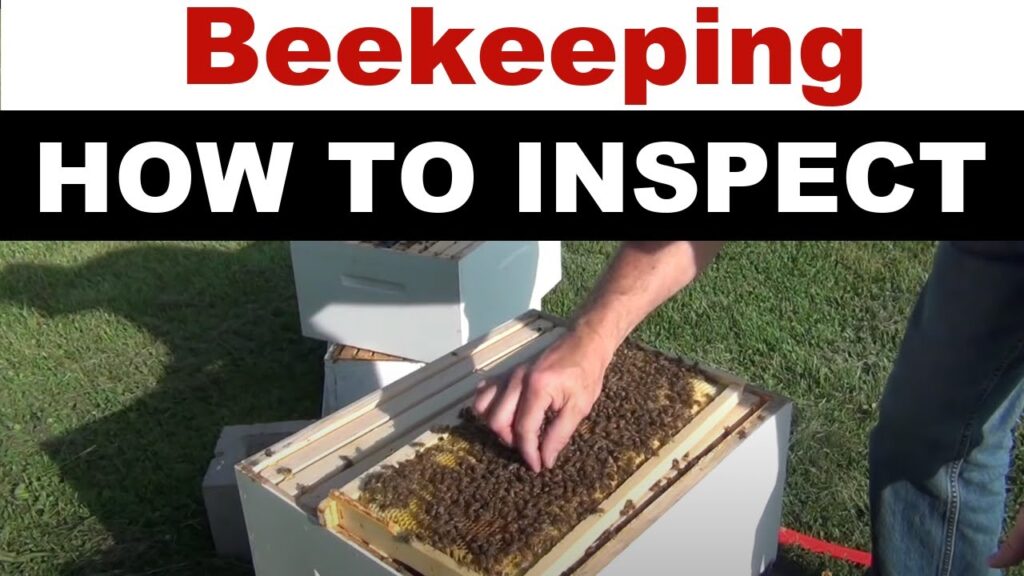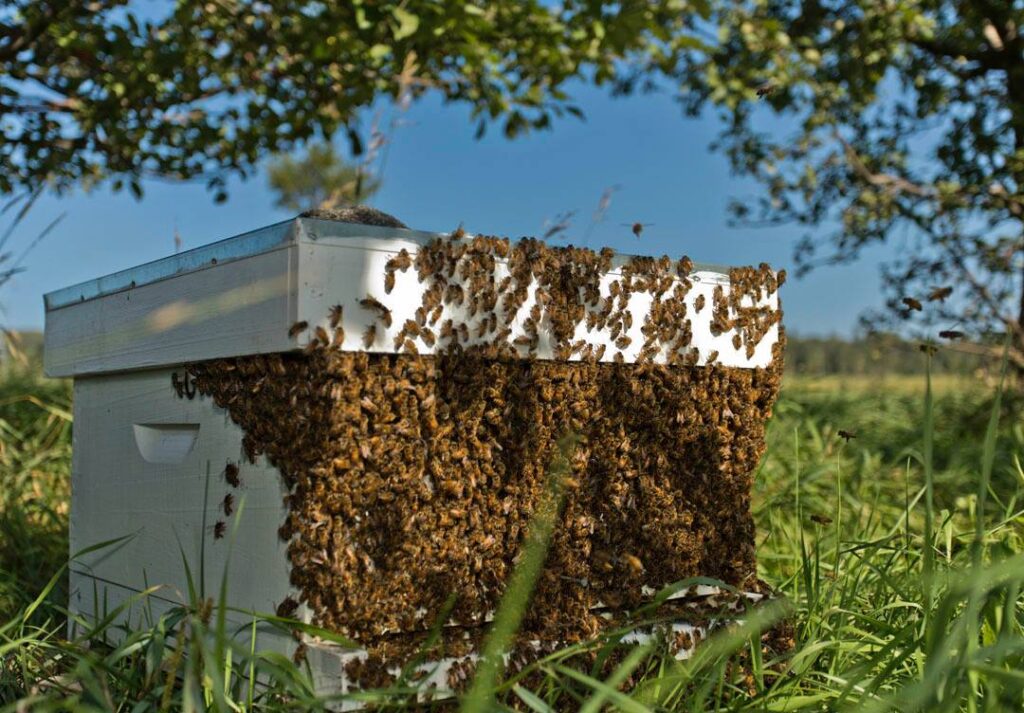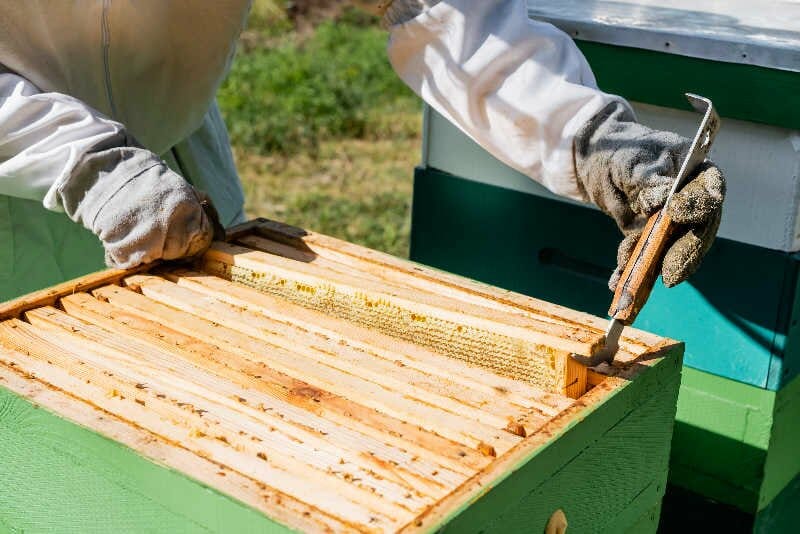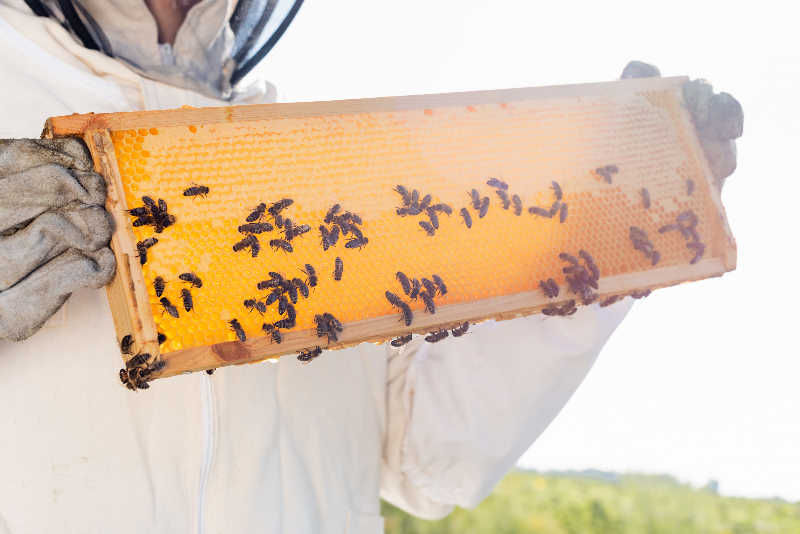
In the world of beekeeping, regular hive monitoring is essential for the health and productivity of your honeybee colonies. By staying vigilant and implementing some helpful tips and tricks, you can ensure the well-being of your bees and maximize your chances of a successful harvest. From checking for signs of disease to maintaining proper ventilation, this article will provide you with valuable insights on how to keep a close eye on your hives and promote thriving bee populations. So grab your beekeeping suit and get ready to learn some expert advice to keep your bees happy and buzzing!

Importance of Hive Monitoring
Keeping a close watch on the health and condition of your bee hives is absolutely crucial for the success and longevity of your honey bee colonies. Hive monitoring serves multiple purposes, and by consistently assessing the well-being of your bees, you can ensure their health, maintain optimal hive conditions, and detect and manage pest and disease infestations before they cause irreparable damage.
Maintaining Bee Health
The primary objective of hive monitoring is to maintain the health of your honey bee colonies. By regularly inspecting your hives, you can identify any potential issues or irregularities that might be detrimental to the health and well-being of the bees. This includes checking for signs of disease, pests, or contamination, assessing honey stores and brood patterns, and monitoring bee behavior. By detecting any problems early on, you can take prompt and appropriate action to prevent the spread of diseases, manage pests, and ensure the overall health and vitality of your bees.
Ensuring Optimal Hive Conditions
Hive monitoring also allows beekeepers to ensure that the conditions within the hive are optimal for the bees. This includes monitoring factors such as temperature, humidity, ventilation, and the availability of food and water. By regularly inspecting the hive and making necessary adjustments, you can provide your bees with the ideal environment for their survival and productivity. Additionally, monitoring hive conditions also helps in preventing issues such as overcrowding, swarming, or weakening colonies, which can have negative consequences on the overall health and productivity of the hive.
Monitoring Pest and Disease Infestations
One of the most critical aspects of hive monitoring is the early detection and management of pest and disease infestations. Honey bee colonies can be vulnerable to a variety of pests, including varroa mites, wax moths, and small hive beetles. The invasion of these pests can weaken the bees, reduce honey production, and even lead to the death of the colony if left unmanaged. By regularly inspecting the hive and monitoring for signs of infestation, such as presence of pests or unusual behaviors by the bees, you can take appropriate measures to control and mitigate the impact of these pests. Similarly, monitoring for common honey bee diseases, such as American foulbrood or chalkbrood, allows for prompt intervention and treatment, minimizing the spread and impact of these diseases on the hive.
Essential Monitoring Equipment
To effectively monitor your hive and conduct inspections, there are several essential pieces of equipment that every beekeeper should have in their arsenal.
Beekeeping Suit and Protective Gear
First and foremost, ensure that you have a proper beekeeping suit and protective gear. This includes a full body suit with veil, gloves, and boots. This protective clothing not only shields you from potential bee stings but also allows you to work with the hive confidently, without posing any risk to yourself or the bees. Protective gear is crucial for your safety and should never be overlooked when monitoring and inspecting your hive.
Hive Tool
A hive tool is an indispensable tool for hive inspections. This versatile implement is used to open the hive, pry apart hive components, and remove frames for inspection. It helps you navigate through the various parts of the hive, such as the hive cover, supers, and frames, while minimizing disruption and damage to the bees and the hive itself. Invest in a good quality hive tool to make your inspections smooth and efficient.
Smoker
A smoker is another essential piece of equipment that plays a vital role in hive inspections. It emits cool smoke that calms the bees, making them less defensive and more manageable during the inspection process. The smoke disrupts their communication and triggers a feeding response, diverting their attention away from the beekeeper. Properly using a smoker can make hive inspections less stressful for both you and the bees, allowing for a more thorough assessment of the hive.
Bee Brush
A bee brush is a gentle way to remove bees from the frames or parts of the hive that you need to inspect. This soft-bristled brush helps to gently sweep bees off the frames without causing harm or agitation. Use the bee brush to clear the area you’re about to inspect, ensuring a clear view and reducing the chances of accidentally injuring the bees or damaging the combs.
Queen Excluder
A queen excluder is a device placed between the brood chamber and the honey supers to prevent the queen from laying eggs in the honey storage areas. This ensures that the honey remains free of brood and helps in maintaining the quality and hygiene of your honey harvest. Using a queen excluder during hive inspections allows you to focus on assessing honey stores without the interference of brood development.
Hive Inspection Sheets
Keeping accurate and organized records is a crucial part of hive monitoring. Having hive inspection sheets or a dedicated notebook allows you to document important information during each inspection. This includes observations such as bee health, hive conditions, pest and disease incidences, and any interventions or treatments carried out. Maintaining proper records helps you track the progress of your hives, identify patterns or trends, and make informed decisions regarding hive management and maintenance.
Frequency of Hive Inspections
Determining the frequency of hive inspections depends on various factors, including seasonal considerations, general guidelines, and special cases such as swarming or weakening colonies.
Seasonal Considerations
During the active beekeeping season, which typically runs from spring to fall, hive inspections should be conducted at regular intervals. In the early spring, when the bees are emerging from winter dormancy, it is important to assess their overall health and strength, as well as their food stores. Inspections during this time also help in identifying any winter losses and preparing the hive for the upcoming season. As the season progresses, regular inspections are crucial for monitoring honey production, brood patterns, and overall hive conditions. During periods of significant nectar flow or strong population growth, more frequent inspections may be necessary to prevent issues such as overcrowding or swarming.
General Guidelines
As a general guideline, it is recommended to inspect your hives every two to three weeks during the active season. This frequency allows you to stay on top of any changes or issues that may arise within the hive. However, it is essential to remember that each hive is unique, and the frequency of inspections may vary based on the strength and health of the colony, local weather conditions, and other factors specific to your apiary. Be attentive and adjust your inspection schedule based on the individual needs of your bees.
Special Cases: Swarming or Weakening Colonies
In special cases such as swarming or weakening colonies, more frequent inspections may be necessary. Swarming is a natural process of honey bee reproduction, where a new queen leaves the original hive with a portion of the worker bees to establish a new colony. To prevent or manage swarming, regular inspections are crucial during the swarming season. Similarly, if you notice signs of a weakening colony, such as reduced bee population, decrease in brood production, or unusual behavior, more frequent inspections can help you identify and address the underlying issues promptly.
Observing Hive Entrances
An essential aspect of hive monitoring is observing the activity happening at the hive entrance. By paying attention to the signs displayed by the bees coming and going, you can gain valuable insights into the overall health and functioning of the colony.
Normal Activity Signs
A healthy hive will display certain signs of normal activity at the entrance. Bees will be entering and exiting the hive in a steady, purposeful manner. You will observe a constant back-and-forth movement without any clusters or congestion at the entrance. The bees will carry pollen and nectar inside, indicating successful foraging. Additionally, guard bees will be present, checking incoming bees for identification and warding off any potential threats. These normal activity signs indicate a strong and vibrant colony.
Indications of Trouble
Observing the hive entrance can also alert you to the presence of potential trouble. If you notice an abnormal increase in dead bees or a pile-up of debris or waste in front of the entrance, it may indicate issues such as pest infestations, diseases, or poor hive conditions. Bees displaying signs of aggression or defensive behavior upon leaving the hive can also be a cause for concern and may warrant further investigation. Observing and responding to these indications promptly can help prevent the escalation of issues and ensure the well-being of your hive.
Monitoring for Pest Intrusion
Monitoring the hive entrance is also important for detecting and managing pest intrusion. Keep an eye out for signs of pests such as varroa mites or small hive beetles on the bees or near the entrance. If you notice bees with deformed wings or crawling or twitching on the ground in front of the hive, it could be a sign of varroa mite infestation. Similarly, if you observe small beetles or larvae in the vicinity of the entrance, it may indicate the presence of small hive beetles. Regular monitoring and proactive measures such as sticky traps or integrated pest management techniques can help control and manage these pests effectively.

Assessing Bee Behaviors
Another important aspect of hive monitoring is assessing the behaviors and activity levels of the bees within the hive. This can provide valuable information about the overall health, stress levels, and environmental conditions experienced by the bees.
Bee Activity Levels
Monitoring bee activity levels gives you insight into the productivity and vitality of the colony. Healthy bees will be actively engaged in various tasks, such as foraging for nectar and pollen, building comb, caring for brood, and defending the hive. A noticeable decline in activity levels could indicate underlying issues such as disease, pests, or environmental stressors. Conversely, an abnormally high level of activity, with bees appearing agitated or in disarray, could signify an emergency situation, such as a predator or disturbance in the vicinity of the hive. Regular monitoring of bee behaviors allows you to quickly identify any deviations from normal activity and take appropriate action.
Abnormal Behaviors
In addition to overall activity levels, monitoring for abnormal behaviors is crucial to identifying potential issues within the hive. Watch for signs of abnormal wing movement, such as trembling or inability to fly, as it could indicate the presence of wing diseases or parasitic mites. Bees engaging in unusual movements, such as twitching or convulsing, may be suffering from poisoning or exposure to pesticides. Aggressive behaviors, such as excessive stinging or attacking each other, could be indications of queenlessness or overcrowding. Being attentive to these abnormal behaviors can help you ensure the overall well-being of your bees and implement timely interventions if necessary.
Aggressive or Defensive Responses
During hive inspections, it is not uncommon for bees to display defensive behavior or become agitated. However, frequent or excessive aggression towards the beekeeper can be a sign of underlying issues within the hive. If the bees become excessively defensive or show signs of aggression, such as buzzing loudly, bouncing off the protective gear, or stinging, it is essential to assess the reasons behind their defensive response. It could result from factors such as poor hive conditions, disturbance of brood or honey stores, or the presence of pests or diseases. Taking note of these defensive responses helps you pinpoint areas that may require immediate attention and implement necessary interventions to address the root cause of the aggression.
Inspecting Honey Stores
Monitoring and assessing the honey stores within your hive is a critical part of hive maintenance and monitoring. Adequate honey reserves are essential for the survival and productivity of the bees, especially during periods of nectar scarcity or unfavorable weather conditions.
Monitoring Honey Quantity
Regularly inspecting the honey stores allows you to estimate the quantity of honey available to the bees. A healthy hive should have sufficient honey reserves to sustain the colony through periods of limited nectar flow, such as winter or periods of drought. Assessing the quantity of honey also helps in determining if supplemental feeding is necessary to ensure the bees have enough food to thrive. It is important to strike a balance between leaving enough honey stores for the bees and harvesting surplus honey, if desired. Monitoring honey quantity ensures that the bees have an ample supply of food to meet their needs while preserving their overall well-being.
Checking for Contamination
Inspecting honey stores is not only about quantity but also about quality. It is important to check for any signs of contamination or adulteration in the stored honey. Look for unusual colors, odors, or textures, which could indicate the presence of contaminants or spoilage. Additionally, monitor for the presence of pests or foreign objects within the honey stores, as this can compromise the quality and safety of the honey. Maintaining clean and uncontaminated honey stores not only ensures the health of the bees but also guarantees the production of high-quality honey.
Assessing Honeycomb Health
When inspecting honey stores, it is also crucial to assess the health and condition of the honeycomb. Honeycomb serves as the foundation for the bees’ storage, brood rearing, and overall hive functioning. Check for signs of damage or degradation, such as broken or misshapen comb, mold growth, or infestation by pests or diseases. If you notice any issues with the honeycomb, take prompt action to repair or replace the damaged comb to maintain the integrity and usability of the hive.

Examining Brood Patterns
The brood patterns within your hive provide vital insights into the reproductive health and overall productivity of the colony. Regular examination of brood frames allows you to assess the quality and health of the developing bees and identify any potential issues.
Identifying Healthy Brood
Healthy brood patterns are an indicator of a thriving hive. When examining brood frames, look for well-defined, concentric rings of brood cells. The brood cells should be filled with healthy larvae and capped cells, displaying consistent colors and textures. The presence of a solid brood pattern, with minimal gaps or spotty brood, indicates a strong and productive queen and a healthy bee population. Identifying healthy brood patterns allows you to ensure the continued growth and productivity of the hive.
Spotting Queen Problems
Brood inspections are also an opportunity to observe the queen and assess her reproductive capabilities. Look for the presence of eggs, as a queen’s primary responsibility is to lay viable eggs. If you notice limited or no eggs, it could be an indication of queen failure or queenlessness. Similarly, check for the presence of queen cells, which can indicate the swarm preparations or potential queen replacement within the hive. Recognizing queen problems early on allows you to take necessary actions, such as requeening or introducing a new queen, to avoid potential issues within the hive.
Detecting Disease Patterns
Another reason to examine brood patterns is to detect potential disease patterns. Diseases such as American foulbrood or chalkbrood can cause visible symptoms within the brood frames. Look for abnormalities such as sunken or perforated cappings, discolored or foul-smelling larvae, or spotty or patchy brood patterns. Identifying disease patterns early on helps in implementing appropriate management strategies, such as disease-specific treatments or hive sanitation protocols, to prevent the spread of diseases and maintain the health of the hive.
Recognizing Pests and Diseases
Effective hive monitoring involves being able to recognize and manage common pests and diseases that can affect honey bee colonies. By familiarizing yourself with these potential threats, you can take proactive measures to protect your bees and minimize their impact.
Common Bee Pests
There are several pests that beekeepers need to be vigilant about. Varroa mites are a common and significant threat to honey bee colonies, causing weakened immune systems, transmission of diseases, and eventual colony collapse if left untreated. Other pests, such as small hive beetles or wax moths, can also wreak havoc on the hive if their populations are not controlled. By regularly inspecting the hive and monitoring for signs of these pests, such as mite droppings or larvae infestation, beekeepers can take timely measures to manage and minimize their impact.
Major Honey Bee Diseases
Honey bee diseases can have devastating consequences if not managed effectively. American foulbrood is a bacterial disease that affects the brood and can cause the rapid decline and death of the colony. Chalkbrood, another common fungal disease, affects the larvae, turning them into chalk-like mummies. These two diseases, along with others such as European foulbrood or nosema, can significantly impact the health and productivity of the hive. By regularly inspecting the hive and monitoring for symptoms, such as foul odors, discoloration, or abnormal brood patterns, beekeepers can take immediate action to treat and prevent the spread of these diseases.
Signs of Infestation or Infection
Recognizing the signs of pest infestation or disease infection is crucial for effective hive monitoring. Keep an eye out for visible signs, such as physical presence of pests, abnormal behaviors or activity levels of the bees, or unusual patterns within the brood frames. Additionally, monitor for symptoms such as foul odors, discolored or malformed larvae, or abnormal comb structures. Early detection of infestation or infection allows for timely intervention and treatment, mitigating the potential damage and protecting the overall health of the hive.

Record Keeping and Documentation
Maintaining accurate and organized records is an essential component of effective hive monitoring. By documenting your observations, interventions, and treatments, you can track the progress and history of your hives, make informed decisions, and identify any patterns or trends that may require attention.
Establishing Hive Inspection Records
Establishing hive inspection records allows you to systematically record and track each inspection you conduct. Include details such as the date of inspection, weather conditions, overall hive health, honey stores, brood patterns, and any observations or abnormalities noted during the inspection. Maintaining a logbook or digital record provides a comprehensive history of each hive, facilitating quick reference and comparison when assessing the progress or identifying any changes within the hive.
Organizing Essential Information
In addition to inspection records, organize other essential information related to your hives. This may include details such as the origin of the colony, the age and breed of the queen, medications or treatments administered, and any notable events or occurrences. Keeping these details organized and accessible helps you have a complete overview of each hive, allowing for effective monitoring and decision-making.
Tracking Interventions and Treatments
When managing pests, diseases, or other issues within the hive, it is crucial to keep track of the interventions and treatments implemented. Document the type of treatment, the date of application, and any observed changes or improvements resulting from the intervention. This helps you monitor the efficacy of the treatments, maintain a comprehensive treatment history, and ensure that appropriate measures are taken as needed.
Conclusion
Regular and comprehensive hive monitoring is an essential practice for every beekeeper. By monitoring bee health, hive conditions, and the presence of pests and diseases, beekeepers can ensure the well-being and productivity of their honey bee colonies. Equipped with essential monitoring equipment and knowledge about hive inspections, bee behaviors, honey stores, brood patterns, pests, diseases, and record-keeping, beekeepers can take proactive measures to address any issues that arise, preserve hive health, and promote thriving bee populations. With consistent and diligent monitoring, you can reap the rewards of healthy, productive bee colonies while contributing to the preservation of these vital pollinators.
